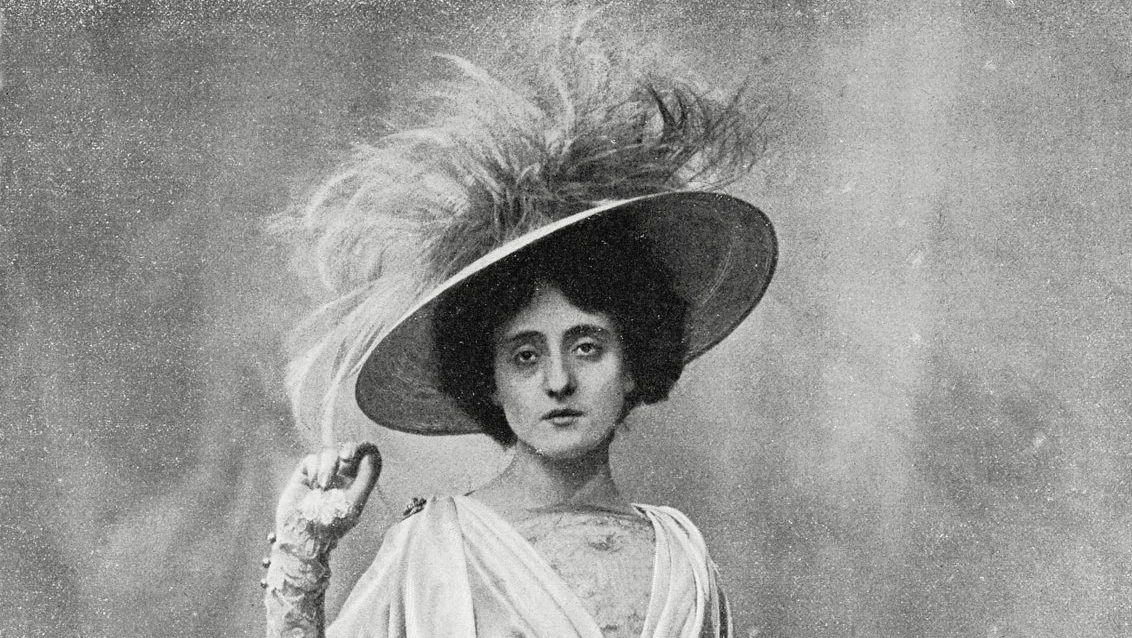We might still speak of the magic of cinema, but it is difficult to imagine just
how magical it must have been in its early years to sit in a darkened room beneath an expanding beam of light in which dust specks drifted and cigarette smoke curled, watching the images conjured as if from the ether, of people moving silently on the screen like exquisite ghosts.
Things were, in truth, a little less magical for the actors themselves. Faces slathered in thick, greasy makeup, they emoted histrionically in front of static cameras, exaggerating expressions and expanding their gestures in an attempt to convey what spoken dialogue could not.
It took something special to stand out as a screen actor in those early days.
Subtlety and nuance were a lot to ask when facial expressions had to be
ramped up to the point of mugging in order to break through the makeup and primitive monochrome of early film. Fortunately for Italian cinema, Lyda Borelli was something special.
Her screen career was short, spanning five years and just 14 films, but Borelli was the first true Italian film star, blazing a trail followed by the likes of Gina Lollobrigida, Isabella Rossellini, Anna Magnani and Sophia Loren.
So significant was her contribution to Italian film that it led to the addition of a word to the Italian dictionary: borellismo, defined by the Dizionario Moderno as “the manner of Lyda Borelli’s gratuitous and aestheticizing poses”, imitated by admirers across the country.
The novelist Lucio D’Ambra wrote of how “this new goddess eclipsed with her aesthetic prestige all the others; young Italian women literally moulded
themselves on this sinuous statue that, struck by love pangs, harmoniously
twisted and turned like a sensual music”.
Borelli’s performances established the archetype of the cinematic diva, a woman of charisma and heightened passions, voluptuous and wronged,
always glamorous even in reduced circumstances, loving and avenging
with equal ardour, often guarding a tragic secret but always facing the world
with chin raised despite being more often than not destined for tragedy (of
her 14 films, Borelli’s characters only survived to the end of six).
In an era when Italian women could neither vote nor divorce, the diva films
of Borelli, combining Catholic Italy’s mater dolorosa with the femme fatale,
offered fleeting escape and brief dreams of aspiration, freedom and at least a degree of agency.
Even Antonio Gramsci described her as “the film artist par excellence in
hich language is the human body in its ever-renewing plasticity”.
She came from two families rooted in the foundation of a unified Italy. Her
maternal grandfather had been killed in 1848 fighting to drive the Austrians
out of Bologna while her father Napoleone, a lawyer from a distinguished Reggio Emilia family, gave up his career to volunteer with Garibaldi, becoming a noted actor once unification was attained. Her mother Cesira was also an actor and encouraged both her daughters on to the stage; older sister Alda would become a stalwart of Italian theatre.
Borelli’s theatrical breakthrough came in 1904 as Favetta in the premiere of Gabriele D’Annunzio’s The Daughter of Iorio in Milan – D’Annunzio became a
lifelong admirer, holding her up as the epitome of Italian womanhood – while the following year her performance in the title role of Victorien Sardou’s Fernanda made her a star first in Italy, then beyond on tours of Spain and South America. Her signature stage role was as Oscar Wilde’s Salome, but it was her screen debut in 1913 that truly catapulted Borelli to celebrity.
The early 1910s had seen dramatic growth in the Italian film industry. In 1912 alone, 569 films were made in Turin and 420 in Rome, and to stand out
among such sheer quantity you needed something of particularly good quality. When, in the summer of 1913, the director Mario Caserini, having just set up his own studio in Turin, persuaded Lyda Borelli in front of his camera, it was a defining moment in the history of Italian cinema.
Ma l’amor mio non muore, (Love Everlasting), ostensibly a period drama set among the Prussian nobility, is effectively a star vehicle for its leading lady. Borelli even plays an actress, allowing her to reprise her legendary Salome in a play-within-a-play. Her character’s dramatic suicide by poisoning and death on stage in front of the man who wronged her is a classic of the diva canon, from the extravagant costume to the protracted, swooning expiration on a conveniently placed chaise longue.
The film was a huge success. One critic called it “the first film to make us forget cinema and absorb the impression of a dramatic work of art”, while another wrote, “Never as in this film, so tender and dramatic, so sumptuous and elegant, has Borelli achieved so much truth”.
Borelli’s performance, which managed despite the technically necessary histrionics to bring a degree of nuance and subtlety to the screen, even stands up today, with the Italian film historian Ivo Blom praising “an incredible range of expression: fleeting moments of anger and disgust that wouldn’t be found on the face of many”.
Other memorable performances followed, notably in 1917’s decadent Rapsodia Satanica, a gender-reversal of Goethe’s Faust, and the ambitiously
fantastical gothic melodrama Malombra, released the same year, in which Borelli’s character is possessed by the malevolent ghost of an ancestor intent on committing murder. She had achieved greatness and was expected to go on to even greater things when, suddenly, everything stopped.
During the summer of 1918 the 34-year-old married the entrepreneur Vittorio Cini, which brought an immediate end to her career and led to well-sourced rumours that Cini even tried to buy up every print of her films to prevent them being screened. Fortunately, he didn’t succeed but, while Borelli’s pre-Raphaelite features can still be found in flickering images online today, her celebrity still wilted with alarming speed.
Despite his wife having created screen divas who certainly went against the fascist ideal of the quiet, God-fearing, baby-producing Italian housewife, Cini went on to become a minister in Mussolini’s government until a late change of heart saw him turn against the Duce, leading to internment in the Dachau concentration camp in 1943 until son Giorgio travelled to Germany and managed to bribe enough people to secure his release.
Giorgio was killed in France in 1949 when his plane crashed shortly after take-off as the pilot turned and flew low over the airfield so Giorgio could wave to his lover, Merle Oberon. It was a tragedy worthy of one of Borelli’s films and one from which she reportedly never recovered.
Her career might have been brief but it blazed, its influence still tangible in today’s screen divas. As Italians emigrated in great numbers to distant parts of the globe, so did her films. Across the US in particular they sat in smoke-filled cinemas and watched as Lyda Borelli shone before them, bringing drama, suspense, tragedy and love from across the Atlantic, the tears dampening their cheeks triggered as much by a yearning for the distant home she represented as the fate of her character.




